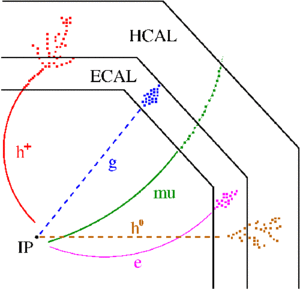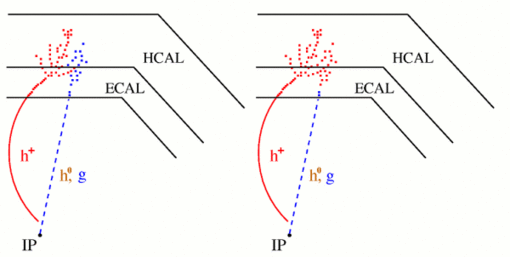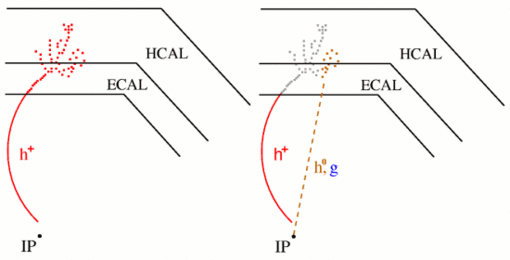Particle Flow
Particle reconstruction
To understand what happens during the collision of two particles, we would like to extract the energy and momentum of all particles created in this collision. These quantities allow us to extract some fundamental properties of nature. They can be determined from measurements carried out with detectors. High energy physics detectors are usually divided into several subdetectors, that are surrounding each other like russian dolls. The main components, available in every high energy physics collision experiment are a tracking device and a calorimetric system. A sketch of the detector topview with an example of particle signatures is plotted in Fig1.
The tracker is located in the center, surrounding the place where the particles collide (interaction point: IP).
It is designed to measure the tracks of all charged particles, e.g. electrons (e)
or charged hadrons (h+), passing through.
From these tracks, we can determine the particles momenta, and we can also draw conclusions on the particle type, such as electron (e),
or proton (h+).
The tracker is surrounded by a calorimetric system, that is again divided into an electromagnetic and a hadronic part.
The calorimeters are capable to measure the energy of charged and neutral particles,
whereas the tracker can only detect charged ones.
Usually the electromagnetically interacting particles, e.g. photons (g) and electrons (e),
are caught in the electromagnetic calorimeter ECAL.
Particles that consist out of quarks so called hadrons, e.g. protons (h+)
and neutrons (h0),
can traverse further into the hadronic calorimeter.
Often the calorimetric system is completed by a muon system that can identify muons (mu).
The combination of all subdetectors allows a precise reconstruction of the interesting physics during the collision of two high energetic particles.
back to top
The particle flow approach
The better the detectors resolution, the more precise we can assign the detector signal to an individual particle, and the more we can learn about the initial collision. The momentum resolution achieved in the tracker is by far the more precise than the energy measurement in the calorimetric system. Therefore, the particle flow approach is to use the best suited detector to measure the individual particles. This means all charged particles should be reconstructed in the tracker and all neutral particles can be determined in the calorimetric system. The combination of either particle type and energy or particle type and momentum, allows us to draw conclusions on the momentum and energy, respectively. This implies the possibility to separate charged and neutral particles in the calorimetric system.
The problem in this reconstruction method is to disentangle the particles that left their signature close to each other (Fig.2, left). In such a case it is hard to distinguish between the energy deposited by the two nearby particles.
If part of, or all of the neutral particles (h0, g) energy is allocated to the charged particle (h+), as sketched in Fig2, the reconstructed energy is too low. The charged particle is correctly reconstructed by the tracker, and the calorimeter information of this particle is not needed. But the neutral particle is invisible in the tracker,and if its energy is assigned to the neighbouring charged track, its reconstructed with too low energy, or not at all. Hence, in the overall event energy is missing.
On the other hand it can as well happen that the opposite effect occurs. Plotted in Fig3 is a case where the energy deposition of a charged particle (h+) is only partially assigned to its track, the remaining energy can be connected to a neutral particle (h0) that has never been there. In this case the charged particle would again be correctly reconstructed from the tracker information, but an additional particle would be introduced. This results in too much energy in the overall event.
Our aim is to keep this kind of confusion as low as possible.
This challenge can be met by a calorimetric system with very high granularity that allows us to separate close by particles, and well trained particle flow algorithms
that are able to do effective clustering.
Our group is active in several fields. We build and test high granular calorimeter prototypes
and develop and test new reconstruction methods on testbeam data,
as well as on full detector simulation and particle flow based reconstruction.
back to top




